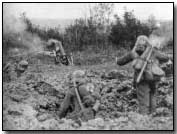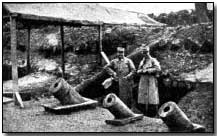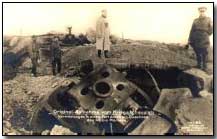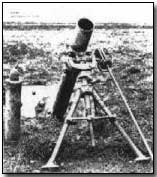Weapons of War - Trench Mortars
 As with the grenade the mortar was yet another old weapon which found a new lease of life during World War One.
As with the grenade the mortar was yet another old weapon which found a new lease of life during World War One.
The Mortar: A Definition
A mortar is essentially a short, stumpy tube designed to fire a projectile at a steep angle (by definition higher than 45 degrees) so that it falls straight down on the enemy.
From this simple description it will be immediately apparent that the mortar was ideally suited for trench warfare, hence the common application of the 'trench' prefix.
Its Advantages Over Artillery
The chief advantage of the mortar was that it could be fired from the (relative) safety of the trench, avoiding exposure of the mortar crews to the enemy. Furthermore, it was notably lighter and more mobile than other, larger artillery pieces. And, of course, the very fact that the mortar bomb fell almost straight down meant that it would (with luck) land smack in the enemy trench.
Just as the mortar was another example of an ancient weapon given fresh reign, so too it was predictable that the German army, so better prepared for war than any of its counterparts in 1914, should have spotted the enormous potential of the mortar some years ahead of the Great War.
The State of Mortar Readiness in 1914
 Indeed,
German military observers of the Russo-Japanese War of 1904-05 not only came
away with a new respect for hand grenades, but with fresh ideas for the use
of the mortar bomb they had seen deployed.
Indeed,
German military observers of the Russo-Japanese War of 1904-05 not only came
away with a new respect for hand grenades, but with fresh ideas for the use
of the mortar bomb they had seen deployed.
In fairness to the Allied powers the Germans had a specific use for the mortar when they began to stockpile it in the immediate pre-war years. In short, they envisaged its use against France's eastern fortresses. Consequently by the time war arrived in August 1914 the Germans had some 150 mortars available.
And what of the French themselves? The re-birth of the mortar caught the French army entirely by surprise, as it did the British. At least the French could scramble to put into use ancient century-old Napoleonic mortars (referred to by the British as Toby mortars in honour of the British officer who had been struck with the idea of securing such old stockpiles of the weapon from the French).
The British however were entirely without supplies of the mortar, it having not been used at all during the South African War of 1899-1902. Even once its merits had been demonstrated by the Germans there were elements within the British high command who argued that it was without much worth. It took David Lloyd George (Prime Minister from late 1915) to push through manufacture of the weapon for it to be taken seriously.
However, as with the grenade, once the British finally grasped the manifest merits of the mortar it was embraced wholeheartedly, and its design much improved upon. Just as the British Mills bomb became the war's most famous hand grenade, so the Stokes bomb became the best-known mortar.
The German 1914 Mortar
 First
things first however.
First
things first however.
The German mortars at the start of the war - translated into German as 'minenwerfer' (literally 'mine-thrower') had been designed in 1908-09 and, at a monster-size 25 cm, were rifled mortars mounted upon field carriages (each mortar of this size weighed approximately 95 kg).
In fact the Germans had three sizes of mortar available. Aside from the huge 25 cm type (the heavy mortar), they had a light mortar (at 7.6 cm) and a medium mortar (17 cm).
Having first put these initial supplies into use on the French front, and having witnessed their results with satisfaction, minenwerfers were quickly put into mass production.
The First British Mortar
In late 1915 the British succeeded in hastening production of their first mortar. It was not of an impressive design, being little more than a 4-inch pipe, without rifling, sighting or recoil.
A simple cylindrical bomb was dropped base first into the pipe so that it fell on to a projecting pin at the pipe's base. This detonated the firing charge and so propelled the missile.
Mortars fired from this device had a maximum range of 1,500 yards and featured a built-in 25-second fuse, although this was soon changed to a percussion (impact) fuse.
The Stokes Mortar
 Given
that the Germans were considerably ahead in mortar preparedness it is
remarkable that the British - and therefore the other Allied armies, since
the British shared production of the mortar - caught up so quickly and
surpassed the Germans in mortar excellence.
Given
that the Germans were considerably ahead in mortar preparedness it is
remarkable that the British - and therefore the other Allied armies, since
the British shared production of the mortar - caught up so quickly and
surpassed the Germans in mortar excellence.
A Mr F.W.C. Stokes - later to become Sir Wilfred Stokes KBE - saved the day for the British in January 1915. That month he designed a mortar of brilliant simplicity. It became the standard issue for the British army for several decades and was the most widely used mortar among the Allied armies. Indeed, most mortars in use today are direct descendants of the Stokes mortar.
Stokes' design was simple but highly effective. It consisted chiefly of a smooth metal tube fixed to a base plate (to absorb recoil) with a light bi-pod mount. When a bomb was dropped into the tube an impact sensitive cartridge at the base of the bomb would make contact with a firing pin at the base of the tube, thereby ejecting the bomb.
3-inches in size the cast-iron mortar bomb itself weighed around 4.5 kg. It was fitted with a modified hand grenade fuse on the front, with a perforated tube (with minor propellant charge) and impact-sensitive cap at the back.
 The
Stokes mortar could fire as many as 22 bombs per minute and had a maximum
range of 1,200 yards.
The
Stokes mortar could fire as many as 22 bombs per minute and had a maximum
range of 1,200 yards.
In addition to the light Stokes mortar the British also produced a 2-inch medium mortar and a 9.45-inch heavy mortar (bizarrely nicknamed 'Flying Pigs' by the British soldier) among other models.
By the final year of the war each British division possessed 24 light Stokes mortars, 12 medium and several heavy models.
Mortar Tactics
Mortars were undeniably effective effective in terms of trench warfare. Soldiers would often strain their ears to catch the "plop!" sound that indicated the firing of an enemy mortar, and consequently hasten into cover.
Inevitably, mortar positions rapidly came under fire from enemy artillery once their presence was detected. For this reason they were unpopular when sited among a given group of infantrymen, for it almost guaranteed a busy time along the trench.
Mortars were variously used to take out enemy machine gun posts, suspected sniper posts or other designated features. Larger mortars were occasionally used to cut enemy barbed wire, generally in situations were field artillery could not be used.
Allied Use of Mortars
Once the Stokes mortar had established itself as a highly successful model, Britain's allies - notably the French - borrowed the design. The British and French in particular worked together on mortar design throughout the war, each improving the other's designs.
Eventually mortar technology had advanced to the point where mortar bombs could be thrown up to around 2 km, but these models required large crews to manoeuvre them around the battlefield.
 Another
type of mortar - the oddly-named Vickers 1.75-inch 'toffee apple' -
possessed a solid shaft surmounted by a spherical bomb.
Another
type of mortar - the oddly-named Vickers 1.75-inch 'toffee apple' -
possessed a solid shaft surmounted by a spherical bomb.
Designed to land on its nose and explode on impact, these often proved unreliable, simply breaking into two pieces on many occasions.
The Canadians (namely Major-General G .L. McNaughton) invented a 91 kg mortar bomb, 9.45-inch in diameter, which the Canadian infantry nick-named the 'blind pig'. Generally unreliable and with a short range of 400 yards it nevertheless provided a boost to Canadian morale.
The Central Powers
Germany's allies by and large relied upon German minenwerfer designs throughout the war, which were always skilfully-produced.
Special minenwerfer battalions were created at the outset of the war that were used to reinforce given sectors at short notice at the disposal of GHQ. In addition to these special battalions, regular divisional and battalion minenwerfer companies were soon established.
By the war's end both sides possessed a full range of mortar bombs, each roughly equivalent in effectiveness to that designed by their enemy - and all potentially highly deadly.
Photographs courtesy of Photos of the Great War website
A "blimp" was a word applied to an observation balloon.
- Did you know?
